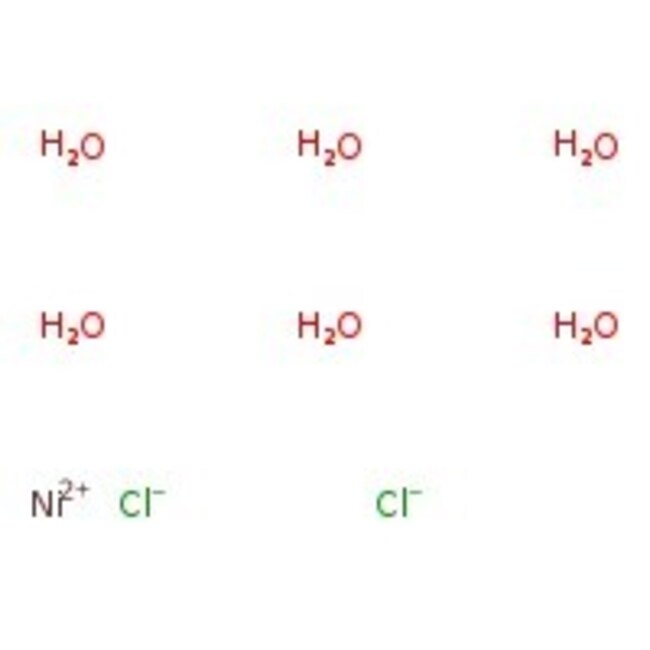Search Thermo Fisher Scientific
Thermo Scientific Chemicals
Nickel(II) chloride hexahydrate, 98%
CAS: 7791-20-0 | Cl2Ni·6H2O
Catalog number A14366.0B
also known as A14366-0B
Price (USD)
146.65
Online Exclusive
163.00Save 16.35 (10%)
Each
-
Quantity:
1000 g
Price (USD)
146.65
Online Exclusive
163.00Save 16.35 (10%)
Each
Chemical Identifiers
CAS7791-20-0
IUPAC Namenickel(2+) hexahydrate dichloride
Molecular FormulaCl2H12NiO6
InChI KeyLAIZPRYFQUWUBN-UHFFFAOYSA-L
SMILESO.O.O.O.O.O.[Cl-].[Cl-].[Ni++]
View more
Specifications Specification Sheet
Specification Sheet
Assay (Titration ex Chloride)≥97.5 to ≤102.5%
Identification (FTIR)Conforms
FormCrystals or powder or crystalline powder
Appearance (Color)Green
Water Content (Karl Fischer Titration)41-49.31% (5-7 waters)
Nickel(II) chloride is used in electroplating and as a catalyst for organic conversions, for example in chemo-selective thioacetalization of aldehydes. In combination with lithium aluminum hydride, it serves as a reducing agent for alkenes, alkynes, and organic halides; it can cleave N-O bond and open epoxides. It is used to prepare a wide array of complexes since water ligands can be easily replaced by amines, thioether, ammonia, and thiolates. It is a precursor to several nickel-phosphine complexes, such as bis(triphenylphosphine)nickel(II) chloride, which are used in alkyne trimerizations, carbonylations, and as catalysts in organic reactions such as Suzuki-Miyaura cross coupling reactions as an alternative to palladium(0) catalysts. It is the precursor to acetylacetonate complex of Ni, used for producing 1,5-cyclooctadiene complex, an important reagent in organonickel chemistry. It can be used to prepare the sandwich compound nickelocene through dimethoxyethane complex of nickel chloride.
This Thermo Scientific Chemicals brand product was originally part of the Alfa Aesar product portfolio. Some documentation and label information may refer to the legacy brand. The original Alfa Aesar product / item code or SKU reference has not changed as a part of the brand transition to Thermo Scientific Chemicals.
Applications
Nickel(II) chloride is used in electroplating and as a catalyst for organic conversions, for example in chemo-selective thioacetalization of aldehydes. In combination with lithium aluminum hydride, it serves as a reducing agent for alkenes, alkynes, and organic halides; it can cleave N-O bond and open epoxides. It is used to prepare a wide array of complexes since water ligands can be easily replaced by amines, thioether, ammonia, and thiolates. It is a precursor to several nickel-phosphine complexes, such as bis(triphenylphosphine)nickel(II) chloride, which are used in alkyne trimerizations, carbonylations, and as catalysts in organic reactions such as Suzuki-Miyaura cross coupling reactions as an alternative to palladium(0) catalysts. It is the precursor to acetylacetonate complex of Ni, used for producing 1,5-cyclooctadiene complex, an important reagent in organonickel chemistry. It can be used to prepare the sandwich compound nickelocene through dimethoxyethane complex of nickel chloride.
Notes
Store away from incompatible substances such as peroxides, strong acids and potassium.
Nickel(II) chloride is used in electroplating and as a catalyst for organic conversions, for example in chemo-selective thioacetalization of aldehydes. In combination with lithium aluminum hydride, it serves as a reducing agent for alkenes, alkynes, and organic halides; it can cleave N-O bond and open epoxides. It is used to prepare a wide array of complexes since water ligands can be easily replaced by amines, thioether, ammonia, and thiolates. It is a precursor to several nickel-phosphine complexes, such as bis(triphenylphosphine)nickel(II) chloride, which are used in alkyne trimerizations, carbonylations, and as catalysts in organic reactions such as Suzuki-Miyaura cross coupling reactions as an alternative to palladium(0) catalysts. It is the precursor to acetylacetonate complex of Ni, used for producing 1,5-cyclooctadiene complex, an important reagent in organonickel chemistry. It can be used to prepare the sandwich compound nickelocene through dimethoxyethane complex of nickel chloride.
Notes
Store away from incompatible substances such as peroxides, strong acids and potassium.
WARNING: Cancer and Reproductive Harm – www.P65Warnings.ca.gov
RUO – Research Use Only
General References:
- In combination with Zn, effects selective reduction of benzaldehydes to benzyl alcohols, ɑß-enones to saturated ketones, and nitroarenes to anilines: Chem. Pharm. Bull., 38, 2097 (1990).
- Catalyst for Suzuki cross-coupling of arylboronic acids with aryl halides under mild conditions: Tetrahedron Lett., 43, 4009 (2002).
- For a brief feature on uses of NiCl2 and its hydrate in synthesis, see: Synlett, 279 (2003).
- Refat, S. M.; El-Deen, I. M.; Zein, M. A.; Adam, A. M. A; Mohamed I. Kobeasy , M. Spectroscopic, Structural and Electrical Conductivity Studies of Co(II), Ni(II) and Cu(II) Complexes derived from 4- Acetylpyridine with Thiosemicarbazide. Int. J. Electrochem. Sci. 2013, 8, 9894-9917.
- Dhakras, D.; Borkar, V.; Ogale, S.; Jog, Y. Enhanced piezoresponse of electrospun PVDF mats with a touch of nickel chloride hexahydrate salt. Nanoscale 2012, 4, 752-756.
Have questions about this product? Ask our AI assisted search.
This is an AI-powered search and may not always get things right. You can help us make it better with a thumbs up or down on individual answers or by selecting the “Give feedback" button. Your search history and customer login information may be retained by Thermo Fisher and processed in accordance with our
Privacy Notice.


.png-150.jpg)

